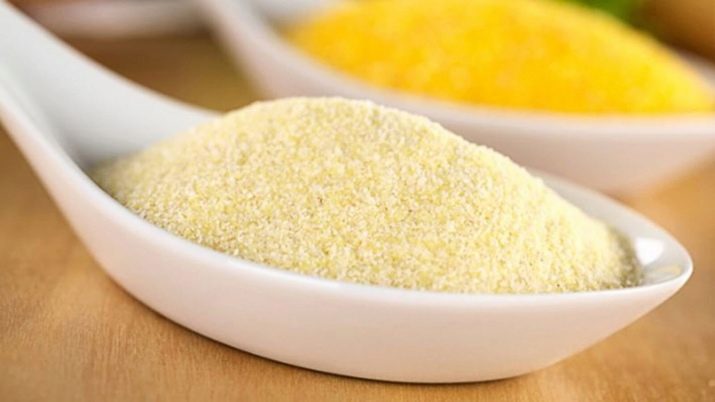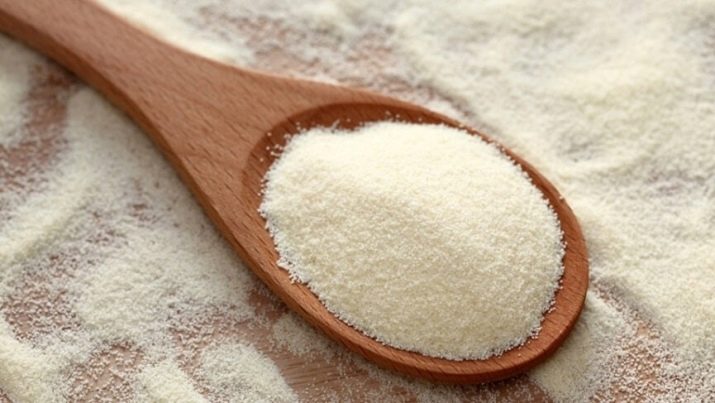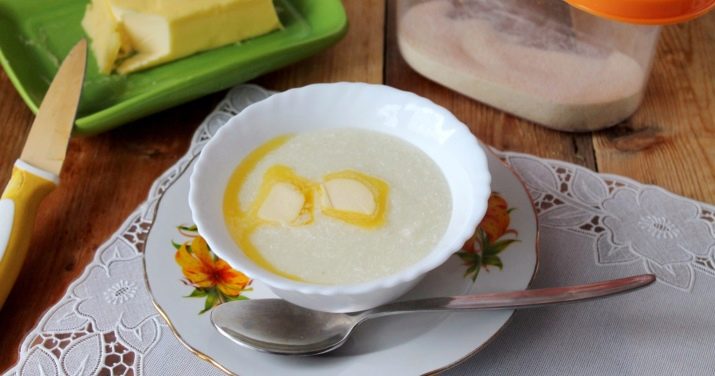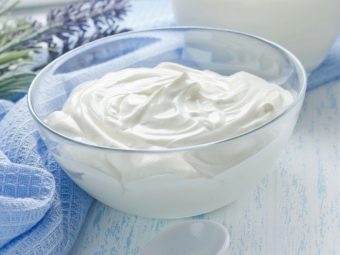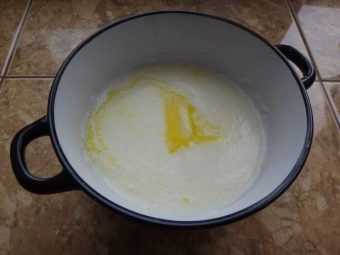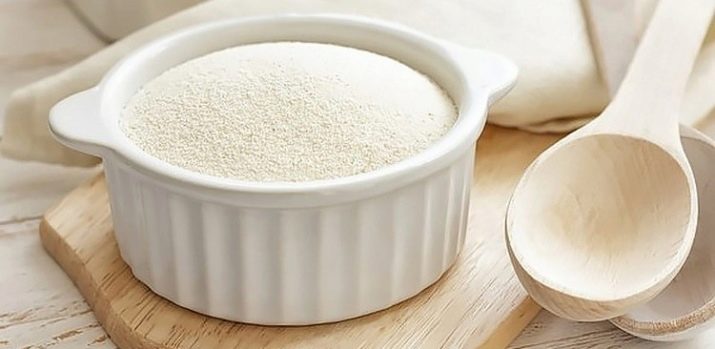Semolina: properties, what is it and what are they made of?
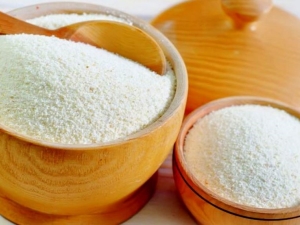
From early childhood, each of us is familiar with semolina, made from white grains of mysterious origin for children.The attitude to taste qualities of semolina in both children and adults is ambiguous. But one thing is obvious: semolina in cooking is an indispensable product, since from it, in addition to porridge, numerous desserts and creams are prepared.
What is it and how does it look?
Semolina in raw form is a collection of absolutely identical in shape small white grains, which, swelling during cooking, form a sticky texture. The color of the cereal, as well as the porridge itself, depending on the variety, can vary from dark white to pure white. Munk, having a wide scope of use, has a fairly low price, which makes it very affordable.
Porridge from semolina, having a fairly high amount of starch, and creams based on it, can have a consistency from extremely liquid to the most thick, depending on the amount of added cereals. It should be noted that an excessive amount of cereal added to the dish makes it lumpy, "rubber".
Due to the gluten it contains, it is quickly digested and easily absorbed by the body. The above properties have made semolina a very popular product, but recently, dietitians have questioned its alleged undisputed benefits on the human body. To understand the alleged harm and benefits, you need to find out from what is made semolina.
What grain is made of?
Semolina is a cereal product because it is made from wheat, which grows in every region. Perhaps this is due to the low price of the product.
From the harvested cereal, the best grains are selected, passing for the manufacture of semolina more than one treatment.
The first is the analysis of the presence of gluten in wheat. The grains are then made dense by a process called “tempering.” Processed and washed grains are purified from the husk, produce coarse grinding.
At the last stage of processing, the semolina is obtained directly, separating it from the casing and grinding it. The final product should be perfectly white, but, as already noted, its color can vary from gray or yellow-white to pure white. It does not depend on the type of wheat (hard or soft), but on the quality of the grains and their processing. Keep in mind that semolina of the highest grade should always be snow white.
Kinds
Numerous varieties of wheat are divided into two main types: soft and hard. And it is the type of source grain that affects the quality of semolina. To prepare a dense consistency of dishes (for example, a souffle), it is advisable to acquire a semolina of durum wheat, which, by absorbing moisture well, gives the dish density. A semolina of soft varieties, on the contrary, makes the dish soft and crumbly, so it is ideal for cooking casseroles and the same porridge.
It is easy to determine the origin of the semolina by special marking on the package: T - made of durum varieties, M - of soft ones. Without available markings, it is possible to determine from which type of wheat a semolina is possible only by the cooking dish.
To make a thick pudding of 1 liter of milk, we need about 3-4 tbsp. spoons of semolina marked "T", and to prepare this same dish of semolina soft varieties, we may need a little more than 5 tablespoons.
It should be noted that on the packages with the considered croup you can see the label “MT”. It is easy to guess that this cereal is represented by a heterogeneous mixture of soft and hard varieties, where the advantage is still soft, which is a percentage of 80 to 20. To deal with the use of a particular variety, you need to consider the composition of each of them.
Composition and nutritional value
In continuation of the topic of hard and soft wheat varieties, I would like to note that they differ in their composition and the content of vegetable protein in them. Its quantity in solid varieties reaches more than 20%, and in soft ones it ranges from 10 to 20%. Protein is the predominant substance (second only to carbohydrates) in semolina, but not the only one.
If we talk about the nutritional value of the product, then the richest in calories is considered to be semolina, made from soft wheat, which in a dry form contains 328 kcal per 100 grams, and semolina from durum wheat is considered to be less calorie, therefore it is recommended to be used by dieters. But when exposed to heat, their number drops to 100, where the BJU will be: 70 g of carbohydrates, 29 g of protein and only 1 g of fat, which should be taken into account for people on a particular diet.
Of course, the fats in the grains are contained in sufficient quantities, but when grinding they, like fiber, are lost. Due to precisely reduced fiber content, the product is quickly digested.
Manka, like potatoes, contains starch, which helps cleanse the stomach. It is because of the moderate fiber content and stomach cleansing properties of starch that semolina always recommend to people who have problems with the digestive tract.
Nourishing semolina and useful substances are not deprived, although in comparison with other products of useful substances it contains at a minimum. It contains zinc (strengthens the immune system, takes part in the formation of bone tissue, improves brain function), is necessary for the growth of potassium, strengthens bones and teeth, phosphorus, iron, which is responsible for hemoglobin, vitamins of group B, E, PP and others that prevent some ills.
The semolina, like many other products, consists not only of useful substances, it also contains negative components. Calcium-magnesium salt phytin contained in it, along with gliadin (a form of protein), can lead to disruption of the absorption of nutrients in the body if consumed excessively. Fitin, on the one hand, has a beneficial effect on the liver, on the other hand, it destroys calcium in the body.
Because of the already mentioned gluten (gluten) and starch, semolina is strictly forbidden to give to children up to a year (it is much more useful to start feeding with vegetable or fruit purees) and people who have stomach ulcers, since these substances can cause inflammation of the latter. In addition, in some cases, gluten causes severe allergies. And carbohydrates contained in large quantities in semolina can contribute to rapid weight gain.
Traditionally, being considered a dairy product, semolina belonged to one of the most useful products, but the composition of this porridge studied recently by experts questioned the unequivocal benefit of the product. It is because of the poor nutritional value and the high amount of carbohydrates and gluten in the composition of semolina is not recommended for pregnant women.
Of course, with a competent approach to nutrition, any product, and semolina, including, does no harm, but will only benefit. Thanks to the satiety, a portion of semolina eaten for breakfast will not cause a search for the often harmful snack. Porridge with a moderate amount of sugar, boiled in milk, will help you quickly recover strength and relieve nervous and physical stress.
Alternating a portion of semolina, cooked nutritionally (without adding oil, water or skimmed milk), with a portion of oatmeal, you can diversify the diet diet without harming yourself. Although it is useful to recall that semolina is not limited to the preparation of banal porridges.
If we consider the nutritional value of dishes, where semolina acts as a certain thickener (cake creams) or baking powder (cottage cheese casseroles), then special emphasis should be placed on this cereal only if it plays the role of the main product in the dish.
For example, semolina is added to the curd casserole so that it is loose and, thanks to gluten, keeps its shape. Naturally, the benefits and harms of semolina cannot be discussed, because cottage cheese is the main product of the recipe.
But with sweet desserts on the basis of semolina you need to be at least cautious persons suffering from allergies or overweight. Since carbohydrate-rich cereals are already due to the combination with sugar, dye and other additives can cause serious harm to people suffering from diabetes.
What can you cook?
The semolina is widely used in cooking and in cosmetology. From it is prepared not only cereals, creams and casseroles, but also various scrubs and masks, significantly improving the complexion. Consider this aspect, starting with cooking.
In addition to traditional dishes from semolina, modern chefs prepare creams from it, dough, and also use as a breading for meatballs and so on. Guided by your imagination and taste preferences, you can even make the semolina unloved by many to be a real masterpiece by combining it with berries, nuts and various spices.
The dough on the basis of semolina, combined with the same unpretentious pumpkin to the compatibility, will have not only an incredible texture, but also a great color and aroma. To make the dish tasty, useful and good looking, you need to remember that the semolina swells a lot, so you need to control its quantity during cooking.
Of course, to see the semolina in the kitchen is a usual thing for many, but it has also proved itself worthily as a cleansing and rejuvenating agent. Thanks to perfectly smooth and round grains of it, they prepare scrubs, which, in combination with sour cream, have a softening effect. If you are the owner of a combination of facial skin and a sour cream based mask does not suit you, then you can easily add a small pinch of semolina to the cream you use and use it as a scrub.
In addition, on the basis of this cereal make whitening, softening and restoring masks.
- To rejuvenate the skin, prepare sparse porridge (2 tablespoons lb. of semolina per 100 ml of milk) add two tablespoons of beer and a small handful of nettle leaves, combined with 1 teaspoon of oil.
- A good nutrient is obtained from a mixture of 10 g of olive oil, one yolk, 5 g of honey and 15 g of semolina.
- To restore 100 grams of thick porridge, add two teaspoons of honey, olive oil, watermelon juice and 0.5 teaspoon of salt. In the mixture add yolk. The mask is ready.
- To cleanse the face, mix one protein with 2 tbsp. spoons of semolina (if desired, you can add 2-3 tablespoons of cucumber juice).
- In the fight against wrinkles will help 3 tablespoons of moderately thick decoy, where add 5 grams of cocoa powder and coconut oil.
- To combat acne, combine 2 teaspoons of cereals with a teaspoon of green clay, dilute the mass with 4 drops of sandalwood oil. Massage the problem areas with the resulting cream for 10 minutes and rinse.
- Oily skin can be cleaned by mixing in a blender one kiwi with two tablespoons of semolina and 10 drops of retinol. Keep on face no more than ten minutes.
- Dry skin is moistened with a mask based on sour cream, which is mixed with warm semolina at the rate of 1 spoonful of sour cream with high fat content per 3 spoons of cereal. To the resulting texture add 3 drops of mint oil.
Nowadays, the use of semolina as a dish is questioned by experts, but semolina is widely used in cosmetology.
About why doctors do not recommend giving semolina to a child, see below.

